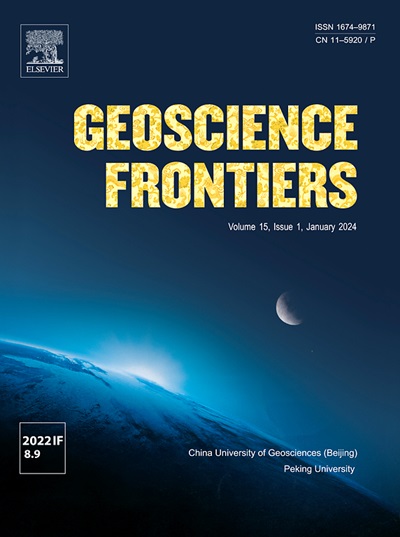埃及西奈半岛Katherina环杂岩Rodinia碎裂至Gondwana组的地球动力学记录:整体地球化学、全岩Sr-Nd同位素和锆石U-Pb-Hf数据
IF 8.9
1区 地球科学
Q1 GEOSCIENCES, MULTIDISCIPLINARY
引用次数: 0
摘要
阿拉伯-努比亚地盾(ANS)是一个重要的地质档案,保存了与Rodinia分裂(~ 900-800 Ma)和Gondwana形成(~ 800-620 Ma)相关的构造-热演化。Katherina环杂岩(KRC)位于埃及西奈半岛(ANS北部),是多阶段岩浆作用和造山作用的例证,跨越了东拉纪到埃迪卡拉纪(~ 900-530 Ma)。尽管它的重要性,但关于其组成单位的性质、年龄、地壳特征和岩浆来源演化的争论仍然存在。Wadi Rofaiyed铜矿位于KRC西北部,由于其极好的暴露和保存,为研究这一时期的大陆地壳形成提供了一个特殊的自然实验室。该研究整合了详细的野外工作、岩石学分析、全岩地球化学、Sr-Nd同位素和原位锆石U-Pb-Lu-Hf同位素数据。其目的是(1)为KRC未变质深成岩建立一个强有力的年代学框架,(2)推进对相关地球动力学过程的理解,(3)阐明幕式岩浆活动事件。结果表明,Wadi Rofaiyed幼年地壳发育了4个主要阶段:(i)俯冲-增生期(~ 755 Ma),以强烈的钙碱性岩浆活动为特征,起源于基性下地壳的部分熔融;(ii)在撒哈拉变质克拉通与较年轻的ANS地壳碰撞期间,发生了一个同步碰撞阶段(~ 630 Ma),产生了岩浆混合和地壳深熔形成的i型花岗岩;(iii)碰撞后阶段,以中间i型(~ 595 Ma)至长英质a型碱性岩浆(~ 594 Ma)为特征,起源于岩石圈剥离引起的过厚下地壳的部分熔融;(iv)与大冈瓦纳最终合并有关的造山期(~ 530 Ma)。4个岩浆相的同位素分析均显示初始87Sr/86Sr较低(0.702648 ~ 0.703311),且εHf(t)(+2.84 ~ +7.78)和εNd(t)(+2.61 ~ +5.21)为正值,与低地壳源特征一致。锆石Hf (1.2 ~ 1.5 Ga)和全岩Nd同位素(0.96 ~ 1.17 Ga)的模型年龄(TDM2)支持这些岩浆岩的主要成因是幼年地壳。这些发现强调了北洋构造-岩浆演化的多阶段性,促进了我们对新元古代的逆冲-吸积动力学和地壳发育的认识。本文章由计算机程序翻译,如有差异,请以英文原文为准。

Geodynamic record of Rodinia breakup to Gondwana formation: Insights from bulk geochemistry, whole-rock Sr-Nd isotopes, and zircon U-Pb-Hf data of Katherina Ring Complex, Sinai Peninsula, Egypt
The Arabian-Nubian Shield (ANS) serves as a key geological archive, preserving the tectono-thermal evolution associated with the Rodinia breakup (∼900–800 Ma) and Gondwana formation (∼800–620 Ma). The Katherina Ring Complex (KRC), located in the Sinai Peninsula, Egypt (northern ANS), exemplifies continental growth through multistage magmatism and orogenesis, spanning the Tonian to Ediacaran periods (∼900–530 Ma). Despite its importance, debates persist regarding the nature, age, crustal characteristics, and magma source evolution of its constituent units. Situated in the northwestern part of the KRC, the Wadi Rofaiyed Cu deposit offers an exceptional natural laboratory for investigating continental crust formation during this interval, owing to its superb exposure and preservation. This study integrates detailed fieldwork, petrographic analyses, whole-rock geochemistry, Sr-Nd isotopes, and in situ zircon U-Pb-Lu-Hf isotopic data. It aims to (i) establish a robust chronological framework for the unmetamorphosed plutonic rocks of the KRC, (ii) advance the understanding of associated geodynamic processes, and (iii) elucidate the episodic magmatism events. The findings show that Wadi Rofaiyed juvenile crust developed in four main phases: (i) a subduction-accretionary phase (∼755 Ma) characterized by intense calc-alkaline magmatism, originating from the partial melting of mafic lower crust; (ii) a syn-collisional phase (∼630 Ma) occurred during the collision between the Saharan metacraton and the younger ANS crust, producing I-type granitoids formed through magma mixing and crustal anatexis; (iii) a post-collisional phase characterized by intermediate I-type (∼595 Ma) to felsic A-type alkaline magma (∼594 Ma), originated from the partial melting of the overthickened lower crust corresponding to lithospheric delamination; and (iv) an anorogenic phase (∼530 Ma) related to the final amalgamation of Greater Gondwana. Isotopic analyses across all four magmatic phases reveal low initial 87Sr/86Sr (0.702648–0.703311) and positive εHf(t) (+2.84 to +7.78) and εNd(t) (+2.61 to +5.21) values, consistent with lower crustal sources with depleted mantle-like signatures. The model ages (TDM2) for these magmatic rocks derived from zircon Hf (1.2–1.5 Ga) and whole-rock Nd isotopes (0.96–1.17 Ga) support a predominantly juvenile crustal origin. These findings underscore the multistage tectono-magmatic evolution of the northern ANS, advancing our understanding of obduction-accretion dynamics and crustal development during the Neoproterozoic.
求助全文
通过发布文献求助,成功后即可免费获取论文全文。
去求助
来源期刊

Geoscience frontiers
Earth and Planetary Sciences-General Earth and Planetary Sciences
CiteScore
17.80
自引率
3.40%
发文量
147
审稿时长
35 days
期刊介绍:
Geoscience Frontiers (GSF) is the Journal of China University of Geosciences (Beijing) and Peking University. It publishes peer-reviewed research articles and reviews in interdisciplinary fields of Earth and Planetary Sciences. GSF covers various research areas including petrology and geochemistry, lithospheric architecture and mantle dynamics, global tectonics, economic geology and fuel exploration, geophysics, stratigraphy and paleontology, environmental and engineering geology, astrogeology, and the nexus of resources-energy-emissions-climate under Sustainable Development Goals. The journal aims to bridge innovative, provocative, and challenging concepts and models in these fields, providing insights on correlations and evolution.
 求助内容:
求助内容: 应助结果提醒方式:
应助结果提醒方式:


